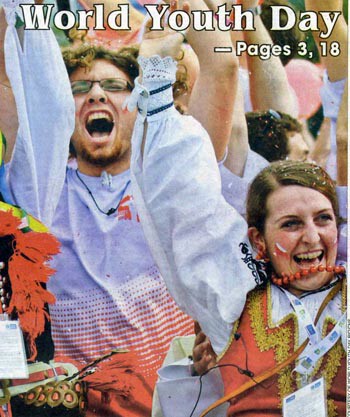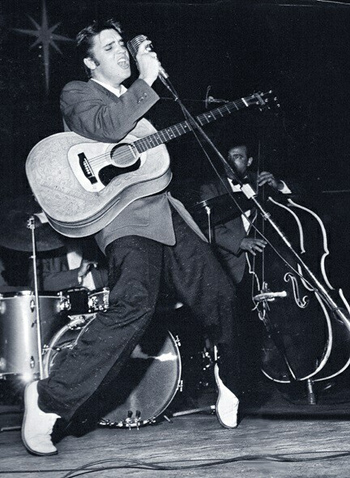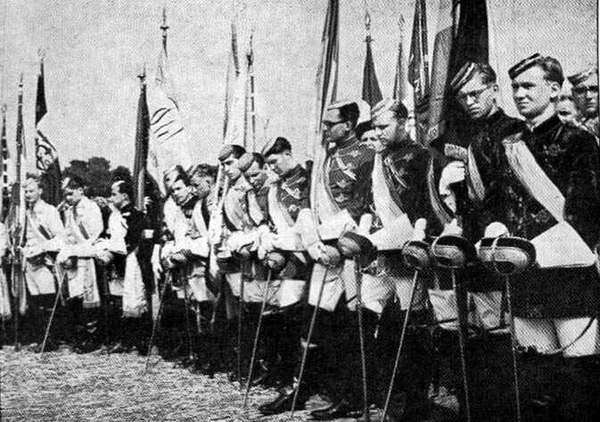Ambiences and Tendencies
 |
 |
 |
 |
 |
 |
 |
Catholic Mainstream Enters the Frenzy
The picture you see below right is promotional. That is to say, its intent - or raison d' être - is to advance a cause. At first glance, one might think the picture is an illustration for a rock or hippie magazine. On the contrary, it is shamelessly presented as the cover page for the diocesan newspaper The Catholic Voice of the Diocese of Oakland, California in the August 12, 2013 issue.
 With the bold caption "World Youth Day," the message is crystal clear. The diocese is praising the disgusting "Catholic" carnival held recently in Rio de Janeiro, Brazil, a fleshy spectacle that would have made pre-conciliar Catholics blush.
With the bold caption "World Youth Day," the message is crystal clear. The diocese is praising the disgusting "Catholic" carnival held recently in Rio de Janeiro, Brazil, a fleshy spectacle that would have made pre-conciliar Catholics blush.
In the picture the young man at left expresses a tumultuous and agitated emotion; he is overtaken by the feelings of the moment, his sensibilities completely unguided by the intellect. He could easily be at a rock concert, but he is not. He is at the Church-sponsored World Youth Days celebrating the arrival of Pope Francis.
That this frenzied close-up can be presented as a paragon for Catholic youth and for the "Church of the future" says much about how public opinion has changed in the half century since Vatican II. Truly, the Church is adapting to and following the styles, music and fashions of the modern world.
The whole WYD scenario reminded me of an article I read some years ago by Prof. Plinio Corrêa de Oliveira, my mentor in the counter-revolutionary fight. In it he astutely discerns the direction Progressivism was taking the world. Let me note that today the Cultural Revolution has entered boldly and blatantly inside the walls of the Church, an action he would have combated with even more fierceness because of the damage it inflicts on souls and society.
The title of the article is "Was Youth Made for Pleasure or Heroism?" (1), a part of which I have quoted in another article. For the benefit of readers, I believe it appropriate to present the whole piece, which is short - only 750 words.
Was Youth Made for Pleasure or Heroism?
Plinio Corrêa de Oliveira
With guitar in tow and microphone in hand, the world champion "artist" of frenzy is sending thousands of youth into delirium. Surrounded by band instruments, Elvis Presley sings and dances before a crazed audience.
 In man, the intelligence should direct the will, and both should in turn enlighten the sensibility, guiding and supporting it against its own natural weakness. For of the human faculties (intelligence, will and sensibility) - all noble in themselves but all affected by original sin - it is the sensibility that most frequently begins the disorders, crises and confusions.
In man, the intelligence should direct the will, and both should in turn enlighten the sensibility, guiding and supporting it against its own natural weakness. For of the human faculties (intelligence, will and sensibility) - all noble in themselves but all affected by original sin - it is the sensibility that most frequently begins the disorders, crises and confusions.
On the contrary, everything about the bearing, gestures and physiognomy of this poor young man indicates a total unleashing of the sensibility, which completely subjugates the will and dictates the movements of his body, where one finds absolutely nothing of equilibrium, good sense, inherent composure and upright action of the intelligence.
To allow the intelligence and will to be directed by the sensibility is to reverse the natural metaphysical order of the soul and to produce chaos. Accordingly, the unleashing of the sensibility in the performer causes movements in which one finds absolutely no equilibrium, good sense or composure, all of which are inherent to the directive action of the intelligence.
In this case, we are not considering a hypertrophy of the sensibilities in the style of the romantics. Undoubtedly, their excessive emotionalism regarding certain artistic, political, social or literary matters or in reaction to certain personal situations such as that of orphans, widowhood, abandonment, etc. was censurable. From a certain perspective, the error of Romanticism lies in making the sentiment the apex and end of all intellectual life. An error, without doubt, and a grave one, which produced dire consequences in the history of Western culture. But it was an error that at least still presupposed a truth, namely, that feeling is one of the integral elements of the intellectual process.
In the picture above, there is a mere vibration of nerves. Overexcited and sick nerves, which vibrate for no reason, without any point of departure or any objective other than the morbid pleasure of vibrating, generating a frenzy that calls for continuously greater vibrations. Thus one rapidly reaches the extremes found here: delirious rhythms, disordered gestures, contorted facial expressions, and finally, a whole ensemble of disorders typical of those who, according to the incisive expression of Dante "have lost the light of the intellect."
In short, if a drunkard were to sing and dance, he would do it in an agonizing way like this. A contagious drunkenness that spreads like a new 'Saint Vitus dance' [the neurological disorder Sydenham's chorea.] to millions of person. A drunkenness much more dangerous than that caused by alcohol because it indicates a fundamental disorder in the soul that does not pass away like the effects of wine.
*

Alongside this lamentable manifestation of interior indiscipline of so many youths of our day, the photo above, showing German Catholic students who participated in the 1954 Katholikentag, presents a shining contrast and constitutes a fine standard and beautiful example of youth.
The countenances of these youth express the habit of concentration and study, created by a profoundly serious intellectual formation beginning in primary school. There is a physical vigor resulting from the training of the body, contained within its proper limits and without the exaggerated "sports" frenzy we see so often among us today. The bearing of these youth is firm, without any softness, which makes us see in these young men not only future intellectuals but also men disposed for action and combat.
*
The traditional attire of these German students corresponds completely to this concept of youth. On one hand, their clothing is cheerful, varied and practical as is suitable for young men. On the other hand, it has the distinction proper to students who know how to respect themselves and the things of the spirit to which they have dedicated themselves. The sword, reminiscent of the heroic medieval combat, adds a note of militant idealism, and simultaneously perpetuates the tradition of fencing, the intellectual sport par excellence since it is admirably apt in forming attention, astuteness, initiative, and panache as it sets the whole body into action.
In this picture, everything makes one think of the great truth enunciated by Claudel: "Youth was not made for pleasure, but for heroism." In contrast, everything in the first picture seems to say to us that youth was not made for heroism but for pleasure. Or, worse yet, for sensuality.
Comparing the first WYD picture to both of these photos analyzed by Prof. Plinio, we can ask if the youths in it appear more like Elvis Presley or the German students of 1954? The answer is not difficult...
Other questions arise: Are the youths who swarm to the World Youth Days attending for serious Catholic orientation or to vibrate with the waves of emotions that overflow at them? Is the frenzy we see at the WYD events essentially different from that at rock concerts? Why do Catholic organs like The Voice mindlessly promote these events with nary a caveat? Is today's Catholic youth being prepared for pleasure or for heroism?

Posted September 27, 2013

In the picture the young man at left expresses a tumultuous and agitated emotion; he is overtaken by the feelings of the moment, his sensibilities completely unguided by the intellect. He could easily be at a rock concert, but he is not. He is at the Church-sponsored World Youth Days celebrating the arrival of Pope Francis.
That this frenzied close-up can be presented as a paragon for Catholic youth and for the "Church of the future" says much about how public opinion has changed in the half century since Vatican II. Truly, the Church is adapting to and following the styles, music and fashions of the modern world.
The whole WYD scenario reminded me of an article I read some years ago by Prof. Plinio Corrêa de Oliveira, my mentor in the counter-revolutionary fight. In it he astutely discerns the direction Progressivism was taking the world. Let me note that today the Cultural Revolution has entered boldly and blatantly inside the walls of the Church, an action he would have combated with even more fierceness because of the damage it inflicts on souls and society.
The title of the article is "Was Youth Made for Pleasure or Heroism?" (1), a part of which I have quoted in another article. For the benefit of readers, I believe it appropriate to present the whole piece, which is short - only 750 words.
Plinio Corrêa de Oliveira
With guitar in tow and microphone in hand, the world champion "artist" of frenzy is sending thousands of youth into delirium. Surrounded by band instruments, Elvis Presley sings and dances before a crazed audience.

On the contrary, everything about the bearing, gestures and physiognomy of this poor young man indicates a total unleashing of the sensibility, which completely subjugates the will and dictates the movements of his body, where one finds absolutely nothing of equilibrium, good sense, inherent composure and upright action of the intelligence.
To allow the intelligence and will to be directed by the sensibility is to reverse the natural metaphysical order of the soul and to produce chaos. Accordingly, the unleashing of the sensibility in the performer causes movements in which one finds absolutely no equilibrium, good sense or composure, all of which are inherent to the directive action of the intelligence.
In this case, we are not considering a hypertrophy of the sensibilities in the style of the romantics. Undoubtedly, their excessive emotionalism regarding certain artistic, political, social or literary matters or in reaction to certain personal situations such as that of orphans, widowhood, abandonment, etc. was censurable. From a certain perspective, the error of Romanticism lies in making the sentiment the apex and end of all intellectual life. An error, without doubt, and a grave one, which produced dire consequences in the history of Western culture. But it was an error that at least still presupposed a truth, namely, that feeling is one of the integral elements of the intellectual process.
In the picture above, there is a mere vibration of nerves. Overexcited and sick nerves, which vibrate for no reason, without any point of departure or any objective other than the morbid pleasure of vibrating, generating a frenzy that calls for continuously greater vibrations. Thus one rapidly reaches the extremes found here: delirious rhythms, disordered gestures, contorted facial expressions, and finally, a whole ensemble of disorders typical of those who, according to the incisive expression of Dante "have lost the light of the intellect."
In short, if a drunkard were to sing and dance, he would do it in an agonizing way like this. A contagious drunkenness that spreads like a new 'Saint Vitus dance' [the neurological disorder Sydenham's chorea.] to millions of person. A drunkenness much more dangerous than that caused by alcohol because it indicates a fundamental disorder in the soul that does not pass away like the effects of wine.

Alongside this lamentable manifestation of interior indiscipline of so many youths of our day, the photo above, showing German Catholic students who participated in the 1954 Katholikentag, presents a shining contrast and constitutes a fine standard and beautiful example of youth.
The countenances of these youth express the habit of concentration and study, created by a profoundly serious intellectual formation beginning in primary school. There is a physical vigor resulting from the training of the body, contained within its proper limits and without the exaggerated "sports" frenzy we see so often among us today. The bearing of these youth is firm, without any softness, which makes us see in these young men not only future intellectuals but also men disposed for action and combat.
The traditional attire of these German students corresponds completely to this concept of youth. On one hand, their clothing is cheerful, varied and practical as is suitable for young men. On the other hand, it has the distinction proper to students who know how to respect themselves and the things of the spirit to which they have dedicated themselves. The sword, reminiscent of the heroic medieval combat, adds a note of militant idealism, and simultaneously perpetuates the tradition of fencing, the intellectual sport par excellence since it is admirably apt in forming attention, astuteness, initiative, and panache as it sets the whole body into action.
In this picture, everything makes one think of the great truth enunciated by Claudel: "Youth was not made for pleasure, but for heroism." In contrast, everything in the first picture seems to say to us that youth was not made for heroism but for pleasure. Or, worse yet, for sensuality.
Comparing the first WYD picture to both of these photos analyzed by Prof. Plinio, we can ask if the youths in it appear more like Elvis Presley or the German students of 1954? The answer is not difficult...
Other questions arise: Are the youths who swarm to the World Youth Days attending for serious Catholic orientation or to vibrate with the waves of emotions that overflow at them? Is the frenzy we see at the WYD events essentially different from that at rock concerts? Why do Catholic organs like The Voice mindlessly promote these events with nary a caveat? Is today's Catholic youth being prepared for pleasure or for heroism?

- First published in Catolicismo, n. 72, December of 1956
Posted September 27, 2013
______________________
______________________








